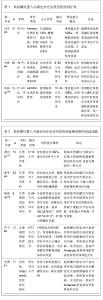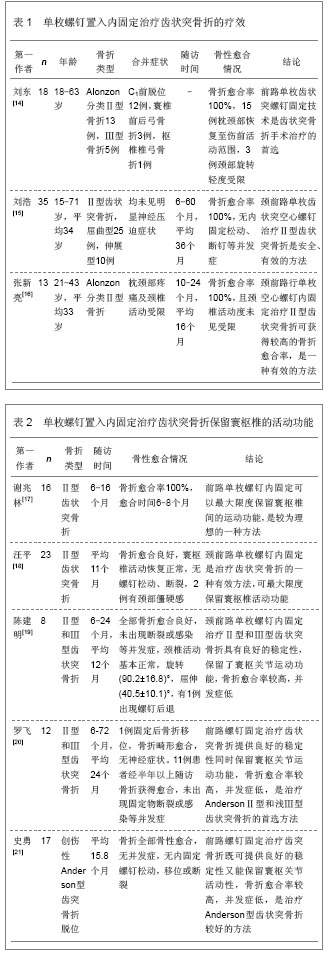| [1] Anderson LD, D'Alonzo RT.Fractures of the odontoid process of the axis.1974.J Bone Joint Surg Am.2004;86-A(9):2081.[2] Demetrios S. Korres, Andreas F. Mavrogenis, et al. Type D fractures of the odontoid process.Eur J Orthop Surg Traumatol. 2010;20(8):597-601.[3] Esses SI, Bednar DA.Screw fixation of odontoid fractures and nonunions.Spine (Phila Pa 1976).1991;16(10 Suppl):S483- 485.[4] Etter C, Coscia M, Jaberg H, et al.Direct anterior fixation of dens fractures with a cannulated screw system.Spine (Phila Pa 1976).1991;16(3 Suppl):S25-32.[5] Apfelbaum RI, Lonser RR, Veres R, et al.Direct anterior screw fixation for recent and remote odontoid fractures.J Neurosurg. 2000;93(2 Suppl):227-236.[6] Rajasekaran S, Kamath V, Avadhani A.Odontoid anterior screw fixation.Eur Spine J.2010;19(2):339-340.[7] Fountas KN, Kapsalaki EZ, Karampelas I, et al.Results of long-term follow-up in patients undergoing anterior screw fixation for type II and rostral type III odontoid fractures.Spine (Phila Pa 1976). 2005;30(6):661-669.[8] Platzer P, Thalhammer G, Ostermann R, et al.Anterior screw fixation of odontoid fractures comparing younger and elderly patients.Spine (Phila Pa 1976).2007;32(16):1714-1720.[9] Koller H, Kolb K, Zenner J, et al. Study on accuracy and interobserver reliability of the assessment of odontoid fracture union using plain radiographs or CT scans.Eur Spine J.2009; 18(11):1659-1668.[10] Marchesi DG. Management of odontoid fractures. Orthopedicss. 1997;20(10):911-916.[11] 陈孝均.Iso-C 3D导航下颈前路空心螺钉治疗齿状突骨折[D].山东:山东大学,2008:6-8.[12] 王晓东.颈前路单枚螺钉内固定治疗齿状突骨折的疗效分析[D]山西:山西医科大学,2009:5-6.[13] 瞿东滨,金大地,江建明,等.齿突形态的测量及临床意义[J].中国临床解剖学杂志,1999,17(4):338-339.[14] 刘东.单枚中空螺钉固定齿状突骨折18例的疗效观察[J].中国伤残医学,2011,19(7):44-45.[15] 刘浩.颈前路单枚空心螺钉治疗齿状突Ⅱ型骨折疗效分析[D].陕西:第四军医大学,2011:6-8.[16] 张新亮,彭焰,梁安靖,等.前路单枚空心螺钉治疗Ⅱ型齿状突骨折[J].实用医学杂志,2011,27 (1):81-82.[17] 谢兆林,江建中,谭海涛.颈前路单枚螺钉内固定治疗齿状突骨折16例[J].广西医学,2010,32 (5):629-630.[18] 汪平,徐振华,娄文杰,等.前路单枚螺钉治疗齿状突骨折的临床观察[J].中华骨与关节损伤杂志,2009,24(11):1037-1038.[19] 陈建明,肖茂明,许天明,等.颈前路单枚螺钉内固定治疗齿状突骨折[J].颈腰痛杂志,2009,30(5):432-434.[20] 罗飞,谢肇,吴雪晖,等.前路单枚空心螺钉内固定术治疗齿状突骨折12例临床报道[J].重庆医学,2007,36(11):1038-1040.[21] 史勇,李涛,刘巍,等.单枚螺钉前路固定AndersonⅡ型齿状突骨折[J].实用骨科杂志,2005,11(3):253-255.[22] 张志成,孙天胜.齿状突骨折的诊断与治疗选择[J].中国脊柱脊髓杂志,2004,14(1):48-50.[23] Lennarson PJ, Mostafavi H, Traynelis VC, et al.Management of type II dens fractures: a case-control study.Spine (Phila Pa 1976).2000;25(10):1234-1237.[24] ElSaghir H, Böhm H.Anderson type II fracture of the odontoid process: results of anterior screw fixation.J Spinal Disord. 2000;13(6):527-530;531.[25] Koller H, Acosta F, Forstner R, et al.C2-fractures: part II. A morphometrical analysis of computerized atlantoaxial motion, anatomical alignment and related clinical outcomes.Eur Spine J. 2009;18(8):1135-1153.[26] Alfieri A.Single-screw fixation for acute Type II odontoid fracture.J Neurosurg Sci.2001;45(1):15-18.[27] Tun K, Kaptanoglu E, Cemil B, et al.Anatomical study of axis for odontoid screw thickness, length, and angle.Eur Spine J. 2009;18(2):271-275.[28] Korres DS, Karachalios T, Roidis N, et al.Structural properties of the axis studied in cadaveric specimens.Clin Orthop Relat Res.2004;(418):134-140.[29] Magee W, Hettwer W, Badra M, et al.Biomechanical comparison of a fully threaded, variable pitch screw and a partially threaded lag screw for internal fixation of Type II dens fractures.Spine (Phila Pa 1976).2007;32(17):E475-479.[30] Ivancic PC, Beauchman NN, Mo F, et al.Biomechanics of halo-vest and dens screw fixation for type II odontoid fracture.Spine (Phila Pa 1976).2009;34(5):484-490.[31] Collins I, Min WK. Anterior screw fixation of type II odontoid fractures in the elderly. J Trauma.2008;65(5):1083-1087.[32] Maak TG, Grauer JN.The contemporary treatment of odontoid injuries.Spine (Phila Pa 1976).2006;31(11 Suppl):S53- 60; S61.[33] Piedra MP, Hunt MA, Nemecek AN.Anterior screw fixation of a dislocated type II odontoid fracture facilitated by transoral and posterior cervical manual reduction.Acta Neurochir (Wien). 2009;151(10):1309-1313. |

